5 Effective Email Strategies for Retailers (Part One)

Internet retailers cannot overlook the value of email.
A Radicati Group study predicts that the total number of email users worldwide will grow to more than 2.7 billion by year-end 2017, with revenue hitting $20.4 billion. This still-growing marketing channel is also fairly inexpensive and is a great resource for retailers trying to acquire and retain customers, increase conversions or generate awareness. After using this channel for a while, however, it can be easy for retailers to fall into an email marketing rut.
When this happens, it is important for retailers to freshen up their campaigns by re-evaluating their current strategies and testing out some new ones. For help, consider these five easy and effective email strategies for retailers.
1. Recover Abandoned Carts
Recovering abandoned shopping carts through email is one of the best ways for online retailers to increase conversions via email. After all, if a visitor spends time browsing through an online catalog and takes the effort to add products to his shopping cart, he probably has a pretty strong intent to purchase. The trick for retailers, however, is to make sure they don't lose the purchase to a competitor. When visitors do leave websites without making purchases, however, retailers can leverage email to retarget them and recover abandoned shopping carts.
Luckily, there are many solutions on the Web that can help retailers with retargeting. Listrak, for instance, offers a shopping cart abandonment solution that enables retailers to target prospects with triggered, personalized messages. Conversely, UpSellit offers an email remarketing platform that has the ability to capture leads as soon as they're typed (even if they are not submitted) and sends recovery messages as soon as a customer leaves the retailer's site.
Retailers implementing a shopping cart recovery campaign should consider using incentives to entice their customers to convert, such as free shipping, free gifts or discounts. Take the example from Victoria's Secret below. The company jumps on the opportunity to not only remind me about a purchase I left in my shopping cart through the email message, but also to promote a discount opportunity to increase the chances of me coming back.
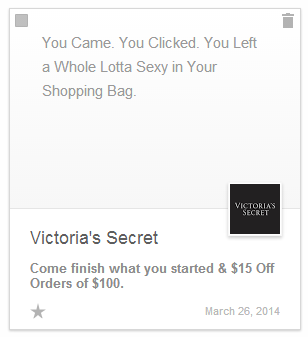
2. Promote Slow Sellers
Unfortunately, not every product is a best seller. This means that retailers need to spend a little extra time generating brand awareness for the products that their customer base might not be familiar with. Identifying these products just requires a quick look at analytics, as slow sellers won't have as many conversions or page views as a retailer's best-selling inventory.
A great example of this strategy comes from Toms. The retailer, which is best known for shoes, created a "6 products that are under the radar" campaign that looks to increase awareness for a variety of inventory, including men's and women's shoes, sunglasses, coffee, jewelry and tech accessories.
To take this strategy a step further, retailers can include promotion codes for their under-the-radar inventory. This will help not only generate awareness for the inventory, but also move it off the shelves. Plus, it should be noted that Experian's Q4 email benchmark report found that emails with coupons have higher open, click and transactions rates, as well as a 48 percent higher revenue per email than other promotional emails.
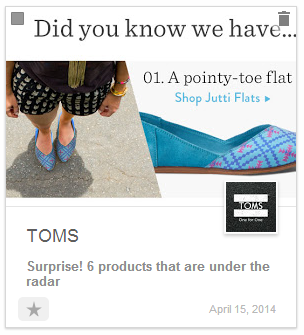
3. Drive Traffic to Other Channels
If you put resources into building a presence in a certain channel, then it is important to take the time to promote that presence. One of the best ways to spread the word, of course, is with email. For instance, if a retailer wants to drive more activity to their Pinterest page, he or she could create an email campaign promoting the page and teasing a special exclusive sneak peek at new inventory for its Pinterest followers. Then the retailer can create a board that features the new inventory a week before promoting it on any other channel.
Another example comes from ModCloth, who leveraged this strategy to increase downloads for the company's mobile app. ModCloth created an email campaign asking subscribers to celebrate the app's first year. The email promoted a surprise incentive (10 percent off a purchase of $75 or more) that was only available to subscribers who downloaded the app. The result likely led to more app downloads and increased conversions for the company.
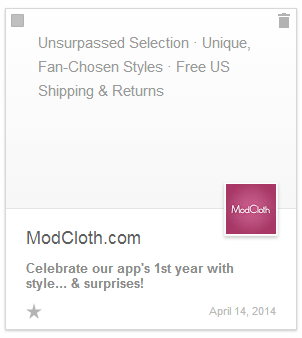
4. Convert Holiday Shoppers
Retailers love holidays, because these special days can help them acquire new customers and increase conversions. By using email to remind subscribers about upcoming celebrations, retailers can push holiday-specific inventory and make it simple for consumers to click through and make a purchase.
Best Buy leveraged this strategy on Easter Sunday, but in order to entice subscribers to take immediate action, the retailer promoted "one-day only sales" for the holiday. In doing so, Best Buy created a sense of urgency for consumers looking to score a good deal on their online purchases.
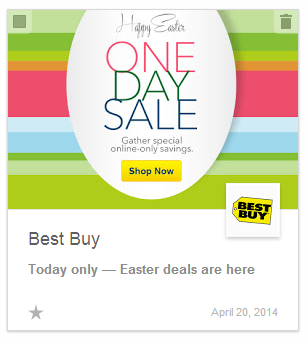
5. VIP Discounts
When your bottom line could use a little boost, consider creating a special campaign for your most loyal customers. One way retailers do this through email is by sending out "Friends and Family" discounts.
In fact, Experian reports that in Q2 2013, friends-and-family emails had transactions rates and revenue-per-email that were more than 75 percent higher than all industry benchmarks. Urban Decay is an example of a brand that has leveraged this strategy with a "Friends & Fanatics" campaign. Through the promotion, shoppers had about a month to use a 20 percent off coupon code on the majority of Urban Decay's inventory, which likely helped the retailer maintain conversions after the holidays (often a slow sales period).
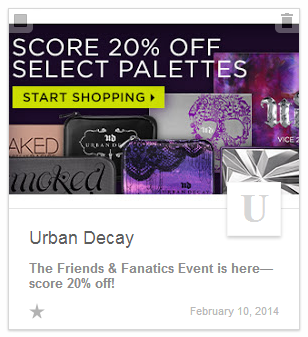
Editor's Note: Stay tuned for next week's part two, which will feature five more effective ecommerce email strategies to consider.




-3-1-1-1.jpg)





